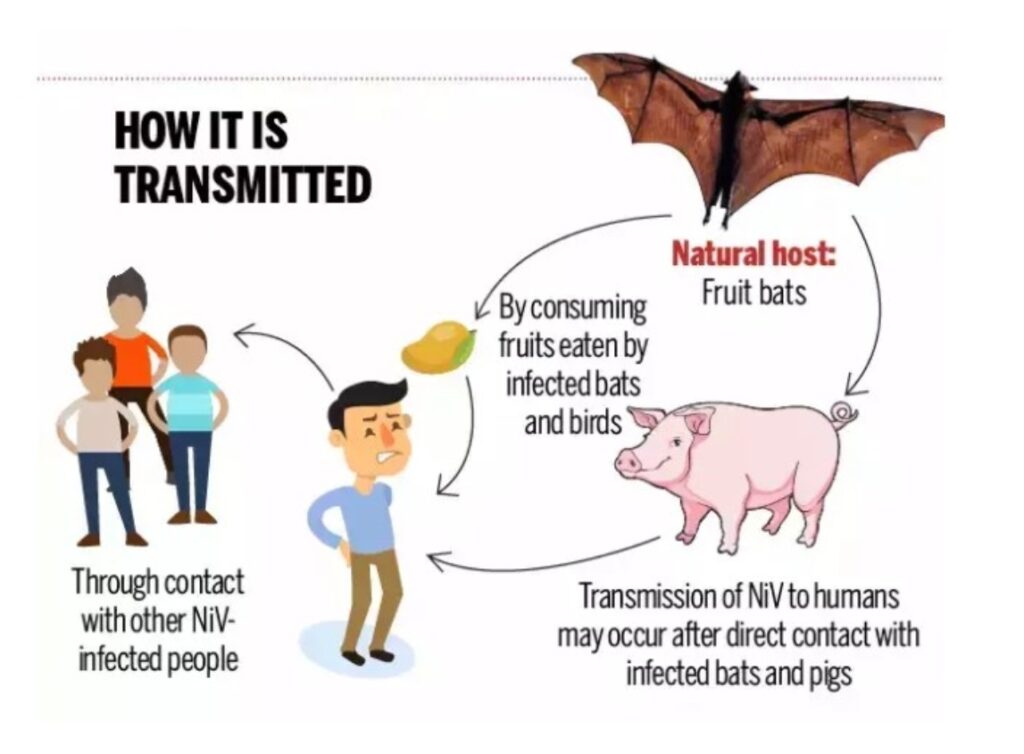ABOUT:
- It is a zoonotic virus (it is transmitted from animals to humans).
The organism which causes Nipah Virus encephalitis is an RNA or Ribonucleic acid virus of the family Paramyxoviridae, genus Henipavirus, and is closely related to Hendra virus.
It first broke out in Malaysia and Singapore in 1998 and 1999.
It first appeared in domestic pigs and has been found among several species of domestic animals including dogs, cats, goats, horses and sheep.
Past Outbreaks
- Nipah virus was first recognized in 1999 during an outbreak among pig farmers in Malaysia when pigs in Malaysian farms came in contact with the bats who had lost their habitats due to deforestation.
- It was also recognized in Bangladesh in 2001, and nearly annual outbreaks have occurred in that country since.
- The disease has also been identified periodically in eastern India.
- In subsequent outbreaks in Bangladesh and India, consumption of fruits or fruit products (such as raw date palm juice) contaminated with urine or saliva from infected fruit bats was the most likely source of infection.

- Transmission:
- The disease spreads through fruit bats or ‘flying foxes,’ of the genus Pteropus, who are natural reservoir hosts of the Nipah and Hendra viruses.
- The virus is present in bat urine and potentially, bat faeces, saliva, and birthing fluids.
- Symptoms:
- The human infection presents as an encephalitic syndrome marked by fever, headache, drowsiness, disorientation, mental confusion, coma, and potentially death.
- Prevention:
- Currently, there are no vaccines for both humans and animals. Intensive supportive care is given to humans infected by Nipah virus.
- Raising awareness: In the absence of a vaccine, the only way to reduce or prevent infection in people is by raising awareness of the risk factors and educating people about the measures they can take to reduce exposure to the Nipah virus.
- Reducing the risk of bat-to-human transmission: Efforts to prevent transmission should first focus on decreasing bat access to date palm sap and other fresh food products.
- Reducing the risk of animal-to-human transmission: Gloves and other protective clothing should be worn while handling sick animals or their tissues, and during slaughtering and culling procedures.
- Reducing the risk of human-to-human transmission: Close unprotected physical contact with Nipah virus-infected people should be avoided. Regular hand washing should be carried out after caring for or visiting sick people
- WHO response:
- WHO is supporting affected and at-risk countries with technical guidance on how to manage outbreaks of the Nipah virus and on how to prevent their occurrence.
- The risk of international transmission via fruits or fruit products (such as raw date palm juice) contaminated with urine or saliva from infected fruit bats can be prevented by washing them thoroughly and peeling them before consumption. Fruit with signs of bat bites should be discarded.
It is essential to detect the cases early and prevent further spread. This is because the Case Fatality Ratio — proportion of deaths among those who test positive for the infection – is very high for Nipah.
NIPAH VIRUS OUTBREAK-
The CFRs in the 2001 and 2007 outbreaks in West Bengal were 68 per cent and 100 per cent respectively. In the case of the 2018 outbreak in Kerala, the CFR stood at 91 per cent with two of the infected persons surviving. To compare, the CFR of COVID-19 in India at present is around 1.2 per cent.
However, the disease is not as transmissible as COVID-19 or influenza and is unlikely to cause a huge number of infections in a short time. “The previous history of infections and the nature of the virus indicate that it cannot spread as fast as influenza, COVID-19 or the very infectious measles,”
https://worldinsightnews.com/libya-flooding-storm-daniel/
BLOG ON G-20 TO G-21- https://worldinsightnews.com/g-20-to-g-21/
INSIGHTS ON BHARAT NAME ORIGIN- https://worldinsightnews.com/bharat-5-fascinating-historical-origins/
SHIVSHAKTI POINT- https://worldinsightnews.com/shiv-shakti-point-on-moon-revelation/#more-239
WANT TO GET INSIGHTS ON RAHUL GANDHI’S INCOMPETENCY – CLICK:“5 Startling Truths About Rahul Gandhi’s Incompetence Exposed”
VIVEK RAMASWAMY – Healer or a double dealing twister?